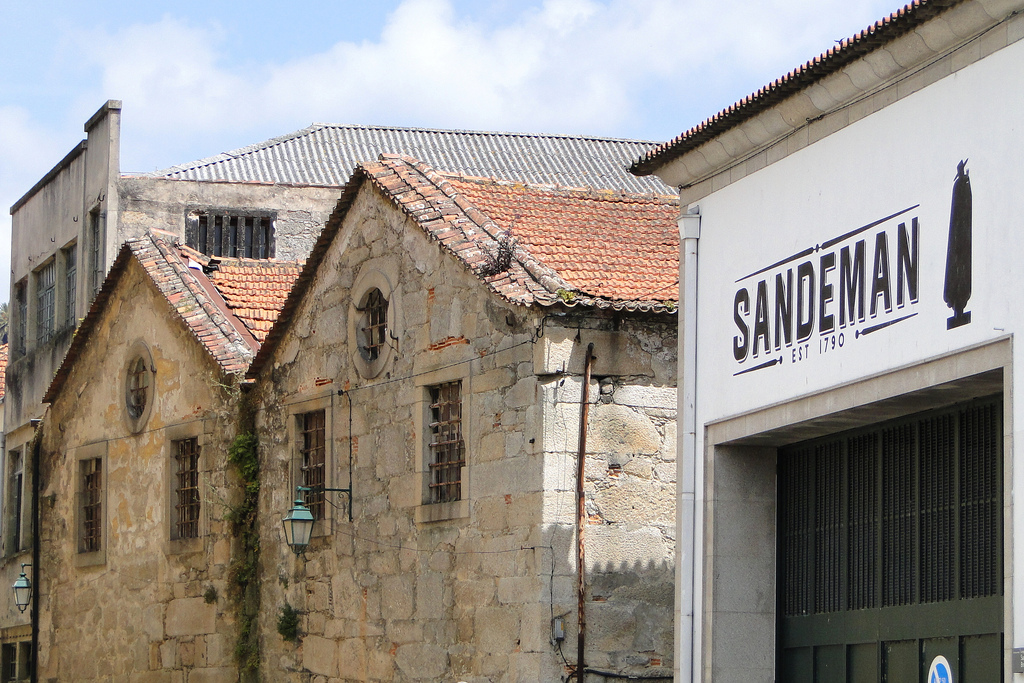Lancaster House is proud to serve the Sandeman range, so much so it’s bar in names after the famous family, The Sandemans Bar.
The principles of Sandeman port production have remained almost unchanged from those employed by George Sandeman in the 1790s. We take a look at how our favourite port is made…

A small selection of the Lancaster House Sandeman Collection
An inhospitable and growing ground
The defined grape-growing region of the Douro Valley extends from 60 miles up river from Oporto to within a few miles of the Spanish border, covering an area of 1,500 square miles.

Vineyard hills in the river Douro valley, Portugal
The valley is well known that the most fruitful vines come from the roughest soil and this is rough! The soil has a high density of schist, slate-like metamorphic rock which is rich in nutrients and having water retaining properties. The steep hillsides are cut deeply to form level terraces, wide enough for only two or three rows of vines. The Port Wine Institute limits each vineyard to the amount of wine it can produce as port in any one year. Quality is thus the key to prosperity for the growers. A vine can yield as little as half a bottle of fine vintage port.

Terraced vineyards in Douro Valley, Alto Douro Wine Region in northern Portugal, officially designated by UNESCO as World Heritage Site
Sandeman has vineyards of its own in the prime heartland of the Alto Douro, but buys the bulk of the grapes needed each year from independent farmers. The arrival of the harvesters from the mountain villages in late September heralds the start of the vintage. It is highly unlikely that there will ever be mechanical harvesting given the steepness of the slopes and inaccessible nature of the terraces. The women skilfully pick the fruit, snipping away unripe or unsound fruit. Filling a basket of about 45 kilos, these are then transferred to much larger baskets which the men carry shoulder-high to the lorry at the bottom of the steep and often crumbling steps.

Pruning grapes by hand
Treading the Grapes
Since the introduction of hydro-electric power in the 1960s, machine crushers have replaced the traditional method of treading the grapes by foot.
The men, with their white pants rolled up to the mid-thigh, step into the lagar and form a line with their arms resting on each other’s shoulders. Measured steps taken at the word of command ‘right’, ‘left’ allow the juice to exude and the grapes become pulp. A livelier movement follows and a fiddler, seated on the edge of the lagar, plays a merry tune, while some of the treaders join in with fife, drum and guitar.
Nowadays once the machines have crushed the pulp it is pumped into stainless steel fermentation tanks. As fermentation occurs, sugar levels are constantly checked and when they reach 6 degree to 8 degrees on the Baume scale the ‘must’ is ready for its union with grape spirit Aguardente (literally ‘firewater’), a colourless, neutral spirit of 77 per cent alcohol. Wine and spirit are mixed four to one as has been customary for at least two centuries. A ‘pipe’ of port is made up of 440 litres of wine and 110 of aguardente. It is a crucial part of the process that the semi-fermented must and the spirit are run simultaneously into the storage vat in order to avoid ‘burn’.
Blending and Storage
From delivery of the grapes to the blending of the spirit takes just three to four days. Throughout the few weeks of the vintage, lorries arrive from the many supplying farms with the loads of grapes that keep the process going day and night. The newly made wine stays in its vats until the New Year.

Everything at the Sandeman Port Winery reflects the Sandeman Don logo (CC 2.0 / Kenneth Fairfax)
Frequent tasting during this period as the wines are continually checked for quality and character. The original style ‘saucer’ or tomboladeira (a saucer with convex centre) is still used – a curious-looking but indispensable vessel unique to the port trade.
In spring the new wines are ready to be moved to the lodges in Vila Nova de Gaia which can house more than 10,000 pipes at any one time. The casks lie three tiers high under dim light – some for 5, 10 or even 20 or more years.

Sandeman Port Winery and Classical Facades – Gaia District – Porto, Portugal (CC 2.0 / Adam Jones)
Enjoy Sandeman’s Port at Lancaster House
At Lancaster House you can enjoy our range of Sandeman’s ports by the glass or in a selcetion of Sandeman’s cocktails.

The Sandaman’s Bar at Lancaster House – Can you spot the iconic “Don”?
